最大线段重合, TopK问题
最大线段重合问题
问题描述
给定很多线段,每个线段都有两个数 [start, end] ,表示线段开始位置和结束位置,左右都是闭区间规定:1)线段的开始和结束位置一定都是整数值;2)线段重合区域的长度必须>=1,也就是说仅顶点重合并不算重合区域。返回线段最多重合区域中,包含了几条线段。
问题分析
我们一步一步分析。
首先,怎么判断两条线段不重合?容易想到,当 line1.left >= line2.right 或 line1.right<=line2.left 时,就可以判定这两条线段不重合了。如下,line1.right<line2.left ,line3.left>line2.right 所以 line2 与 line1、line3 都不重合。

接着,如何判断两条线段不重合?仔细分析后可以发现,当 line1.left<=line2.left<line1.right 时,line1 与 line2 就发生重合(无需考虑 line2.right ),如下图:
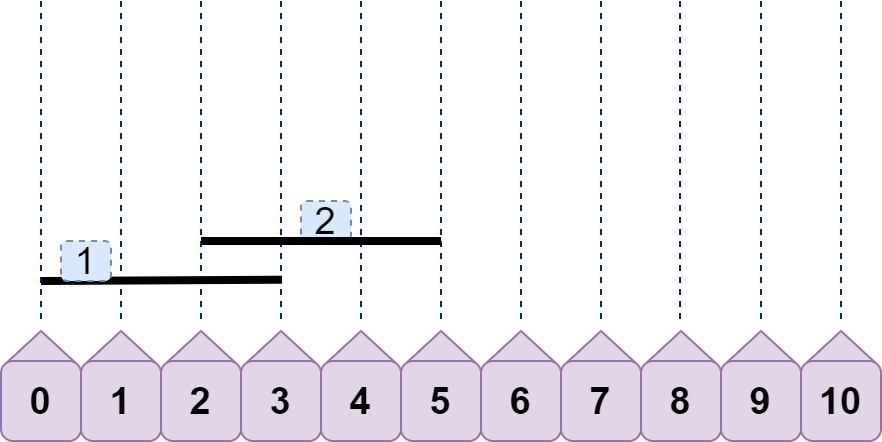
有读者一定会疑问,当 line2.left<=line1.left<line2.right 时,不也能重合吗? 注意,这种情况和上面的情况是相同的,只不过 line1 与 line2 互换了名字而已,这点很重要 。为了避免出现这两种情况的混淆,我们有必要先根据线段左端点的位置给所有线段排个序 ,如下图:
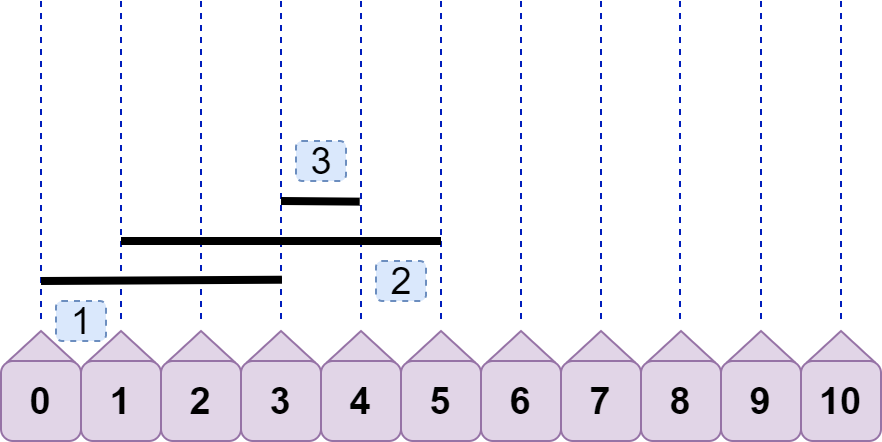
排好序后,我们判断是否重合时,就只需要考虑后面线段的左端点是否大于 前面线段的右端点(基准) ,即只用考虑 line2.left<line1.right ,因为排序后必有 line1.left<=line2.left 。
接着,我们来分析上图中的三条线段。line2.left<line1.right ,故 line2 与 line1 重合;line3.left=line1.right ,故 line3 与 line1 不重合;line3.left<line2.right ,故 line3 与 line2 重合,即现在有两种情况重合,且重合数都为 2。那么问题来了,我们该记录哪种情况的重合数呢?都记录?有必要吗?实际上,只需要记录 line2 与 line3 的重合数即可,这是因为后续加入的线段的左端点不可能小于 3(因为之前我们已经对所有线段完成了排序),所以后续线段不可能再与 line1 发生重合,故可以直接将 line1 丢弃(标记为绿色);如下图:
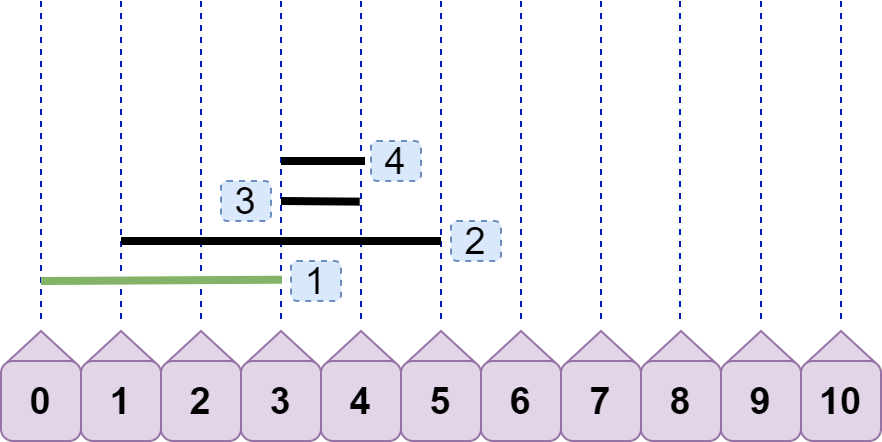
引入 line4,可见现在的最大重合数为 3,但这只是我们看出来的,还需要有一个固定的逻辑比较流程。如何得到最大重合数为 3?line4.left<line2.right 且 line4.left<line3.right ,所以得到重合数为 3?嗯,思路大致没错,聪明的你可能还会继续优化:只需要有 line4.left<line3.right 就可以直接得到 3,你给出的理由是:既然 line3.right<line2.right ,又因为 line4.left<line3.right ,所以一定有 line4.left<line2.right ,即不等式的传递性。果真是这样吗?那如果是下图情况呢:
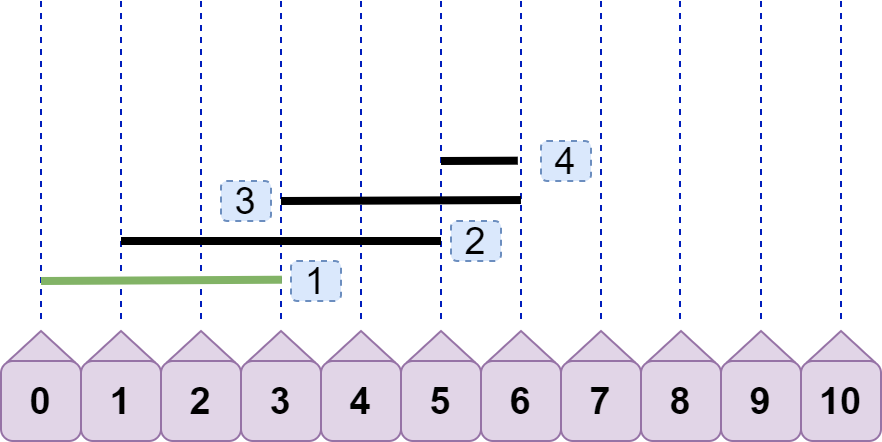
显然,line4.left<=line3.right ,重合数只有 2。但请注意,上图出现了我们之前讨论过的情况:后续线段左节点>=前面线段右节点,即line4.left>=line2.right 。按照之前的方案,我们将先 line2 丢弃:
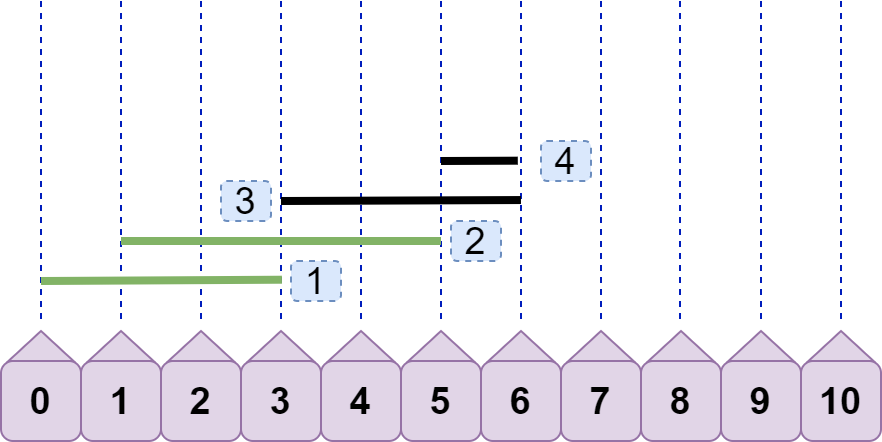
继续,由于 line4.left<line3.right ,所以得到重合数为 2。
由上分析,可知大致比较过程为:当加入新线段 lineN 时,依次丢弃之前的右端点小于等于 lineN.left 的线段,剩下的线段数即为最大重合数。
啊?不对呀?万一碰到下面情况:
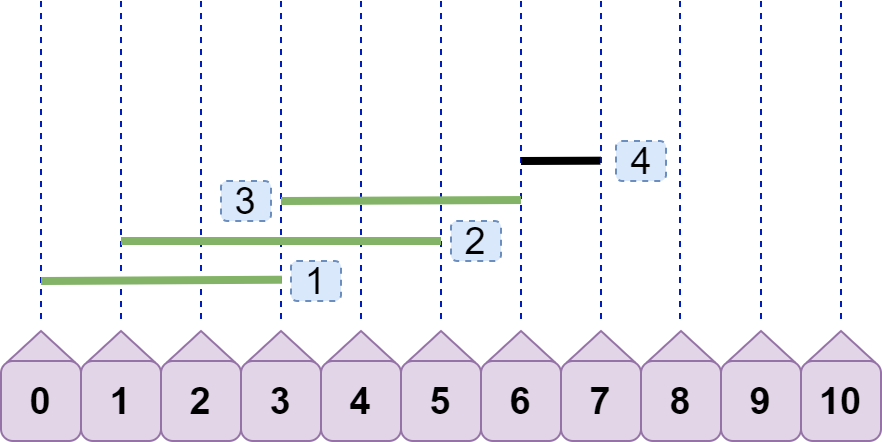
line4 将之前所有线段都弹出了,只剩 line4 一条线段了,但最大重合数不是 1,而是 2 呀!没错,所以我们还需要一个变量 max 来记录最大重合数,若当前重合数 cur>=max ,则 max=cur ;若 cur<max 则 max=max ,即 max=cur>max?cur:max; 。就上图而言,加入 line4 时,max=2;加入 line4 ,弹出之前的线段后,cur=1;cur<max,所以 max 仍然为 2。
下面给出全过程图示:
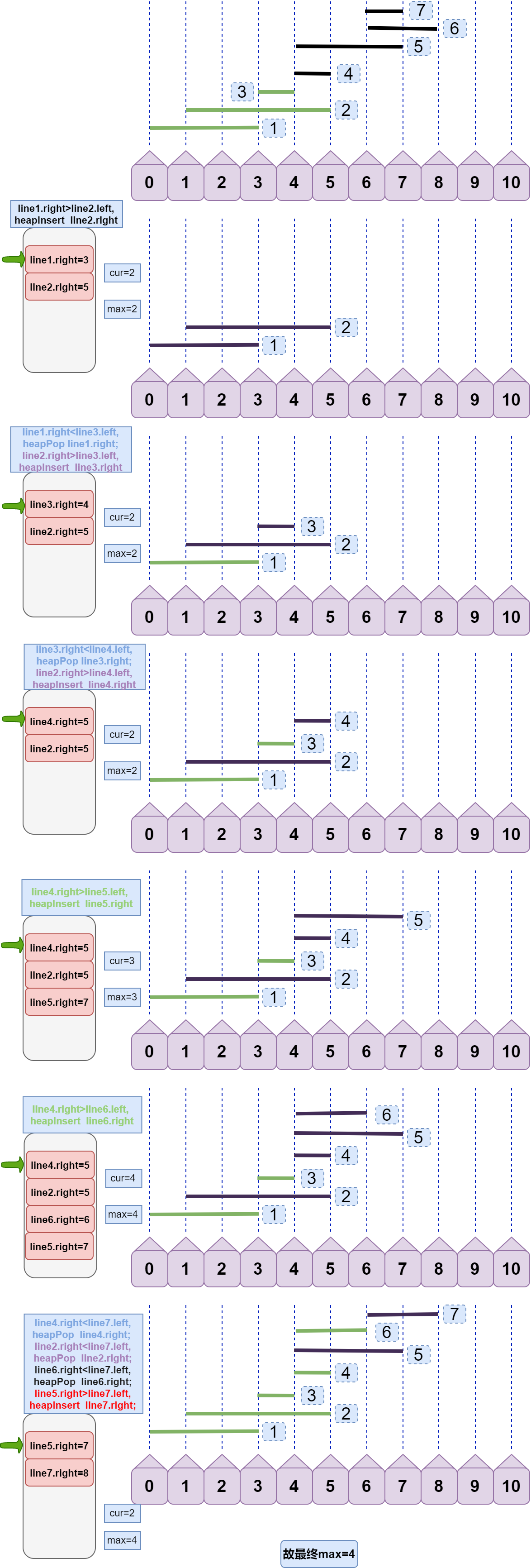
注意:左边灰色大框是堆结构,栈顶为堆中右端点最小的 right。
其实本算法中,堆结构并不关键,堆只是提供了取集合中最小值的便捷,难的还是其过程分析。
#include<iostream>
#include<cstdlib>//rand()
#include<ctime>//time()
#include<algorithm>//sort()
#include<cstring>//memcpy()
#include<algorithm>
using namespace std;
struct line
{
int start;
int end;
};
void heapInsert(line* arr, int cur)
{
if (arr[(cur - 1) / 2].end > arr[cur].end)//小顶堆
{
swap(arr[(cur - 1) / 2], arr[cur]);
heapInsert(arr, (cur - 1) / 2);
}
}
void heaplify(line* arr, int cur, int heapSize)
{
int leftChd = cur * 2 + 1;
if (leftChd > heapSize-1)
return;
int smallest = leftChd + 1 < heapSize && arr[leftChd + 1].end < arr[leftChd].end ? leftChd + 1 : leftChd;//取出左右子树中最小的
if (arr[smallest].end < arr[cur].end)
{
swap(arr[smallest], arr[cur]);
heaplify(arr, smallest, heapSize);
}
}
void heapPop(line* arr, int& heapSize)
{
swap(arr[0], arr[heapSize - 1]);
heapSize--;
heaplify(arr, 0, heapSize);
}
//====================================================================================================
//对数器
line* generateRandomline(int max, int size) {
line* arr = new line[size];
for (int i = 0; i < size; i++)
{
arr[i].start = rand() % max;
arr[i].end = rand() % max;
if (arr[i].start == arr[i].end)
arr[i].end += (rand() % max / 2);
if (arr[i].start > arr[i].end)
swap(arr[i].start, arr[i].end);
}
return arr;
}
line* cpyArr(line* src, int size) {
line* des = new line[size];
memcpy(des, src, size * sizeof(line));
return des;
}
int maxCover2(line* arr, int size)
{
int count = 0;
int minStart = 0;
int maxEnd = 0;
sort(&arr[0], &arr[size], [](line a, line b) {return a.start < b.start; });
minStart = arr[0].start;
sort(&arr[0], &arr[size], [](line a, line b) {return a.end > b.end; });
maxEnd = arr[0].end;
for (int i = 0; i < maxEnd - minStart; i++)
{
int tmp = 0;
double point = (double)minStart + (double)i + 0.5;
for (int k = 0; k < size; k++)
{
if ((double)arr[k].start<point && (double)arr[k].end>point)
tmp++;
}
count = count > tmp ? count : tmp;
}
return count;
}
//==================================================================================================
int maxCover(line* arr, int size)
{
if (size == 0)
return 0;
int heapSize = 0;
int p = 1;
sort(&arr[0], &arr[size], [](line a, line b) {return a.start < b.start; });
int max = 0;
for (int i = 0; i < size; i++)
{
while (true)
{
if (arr[0].end <= arr[i].start && heapSize > 0)//<=
{
heapPop(arr, heapSize);
}
else
break;
}
heapSize++;
arr[heapSize - 1].end = arr[i].end;
heapInsert(arr, heapSize-1);
max = max > heapSize ? max : heapSize;
}
return max;
}
int main()
{
srand(time(NULL));
int testTimes = 1000000;//测试次数
int arrMaxLen = 10000;//数组最大长度
int max = 1000;//线段终点最大位置
for (int i = 0; i < testTimes; i++) {
int arrLen = rand() % arrMaxLen;
line* arr_1 = generateRandomline(max, arrLen);
line* arr_2 = cpyArr(arr_1, arrLen);
int count_1 = maxCover(arr_1, arrLen);
int count_2 = maxCover2(arr_2, arrLen);
if (count_1 != count_2)
{
cout << "count_1 = " << count_1 << endl;
cout << "count_2 = " << count_2 << endl;
for (int i = 0; i < arrLen; i++)
cout << "[" << arr_2[i].start << "," << arr_2[i].end << "]" << endl;
break;
}
cout << i << " success" << endl;
delete arr_1;
delete arr_2;
}
line* arr = new line[8];
arr[0].start = 0, arr[0].end = 8;
arr[1].start = 2, arr[1].end = 6;
arr[2].start = 1, arr[2].end = 5;
arr[3].start = 3, arr[3].end = 5;
arr[4].start = 4, arr[4].end = 5;
arr[5].start = 3, arr[5].end = 4;
arr[6].start = 0, arr[6].end = 2;
arr[7].start = 0, arr[7].end = 1;
int a = maxCover(arr, 8);
}
TopK问题
进行下面问题的探讨之前,请先移步《加强堆》 ,而后此问题将迎刃而解。
TopK实际应用
应用情形
某大型电商举办促销活动,从早上 8 点开始到晚上 12 点结束,这段时间内购买商品最多的前 K 位用户可以获得奖励,最终结果以 12 点的统计情况为准。为了提高用户参与活动的积极性,电商希望在平台官网实时更新并显示当前的得奖区用户(前K位用户)。排名具体规则如下:
1)得奖系统分为得奖区和候选区,任何用户只要购买数>0,一定在这两个区域中的一个;
2)某用户发生购买商品事件,购买商品数+1;发生退货事件,购买商品数-1;如果购买数不足以进入得奖区的用户,进入候选区;
3)每次都是最多 K 个用户得奖,K 也为传入的参数如果根据全部规则,得奖人数确实不够 K 个,那就以不够的情况输出结果;
4)如果某个用户购买商品数为 0,但是又发生了退货事件,则认为该事件无效,得奖、候选名单和上一个事件发生后一致;
5)购买数最大的前 K 名用户进入得奖区,在最初时如果得奖区没有到达 K 个用户,那么新来的用户直接进入得奖区;
6)当前事件发生的时间是指该操作对应的数组下标,比如下面代码中,5 对应的时间为其下标,即 6;
7)如果候选区购买数最多的用户,已经足以进入得奖区,该用户就会替换得奖区中购买数最少的用户( 大于才能替换 );如果得奖区中购买数最少的用户有多个,就替换最早进入得奖区的用户;如果候选区中购买数最多的用户有多个,机会会给最早进入候选区的用户;
8)从得奖区出来进入候选区的用户,进入候选区的时间就是当前事件的时间;从候选区出来进入得奖区的用户,进入得奖区的时间就是当前事件的时间;
其实上述规则虽然很多,但并不复杂,反而非常贴切实际生活,尤其是第 7、8 点,这些规则能够促使你不仅要买的多,也必须买的早。
arr = [3 , 3 , 1 , 2, 1, 2, 5]
op = [T , T , T , T, F, T, F]
以上代码中 arr[ ] 表示客户编号,op[ ] 表示客户操作;数组内容依次表示:3 用户购买了一件商品,3 用户购买了一件商品,1 用户购买了一件商品,2 用户购买了一件商品,1 用户退货了一件商品,2 用户购买了一件商品,5 用户退货了一件商品…
问题分析
注意字眼:“大型电商”——海量数据,“实时更新”——动态插入,“前K位”——优先级队列 。显然,这是一类海量数据+动态插入的优先级队列问题,首先考虑用堆来解决。容易想到,候选区与得奖区应该使用两个堆分别进行维护。又观察到同一个用户可以在多个时间段进行加购和退货操作,所以必须动态调整该用户在堆中的位置,所以考虑使用加强堆 。具体过程如下:

可别忘了规则中提到的几点:
- heap1是候选堆,heap2是得奖区。
- 候选区的堆顶是该堆中购买商品最多的用户,如果多个用户购买商品的数量相同,则时间点早的用户优先。得奖区的堆顶是该堆中购买商品最少的用户,如果多个用户购买商品的数量相同,则时间点早的用户优先。
- 当得奖区用户数没达到 K 时,新用户直接进入得奖区。
- 交换堆顶时,两个用户的时间点都会更新为当前的时间。
代码如下:
#include<unordered_map>
#include<iostream>
#include<vector>
#include<utility>
#include<algorithm>
using namespace std;
struct client
{
int id;
int buy;
int time;
client(int _id, int _buy, int _time) :id(_id), buy(_buy), time(_time) {}
};
struct myKey//自定义哈希规则,注意const不能少
{
std::size_t operator()(const client& a)const
{
return std::hash<int>()(a.id);
}
};
struct isEqual//自定义判断键是否相等规则,注意const不能少
{
bool operator()(const client& a, const client& b)const
{
return a.id == b.id;
}
};
class topK
{
enum hp { cnd, win };//cnd为candidate侯选区,win为得奖区
public:
vector<client> batchRank();//批量排名,数据一次性交付时使用此方法1
vector<client> add(int id, bool buy);//数据动态加入,边加边维护
topK(int*user,bool*buy,int size,int k);
private:
void swap(client& a, client& b, hp p);
void heapInsert(int cur, hp p);
void heaplify(int cur, hp p);
bool comparator(const client& cur, const client& dad, hp p);//比较器,减少了代码量。
void remove(const client& usr, hp p);
void push(const client& usr, hp p);
void swapHeapTops();//交换两个堆的堆顶
void solution(int i);//解决流程
private:
vector<vector<client>> heap;//二维动态数组,heap[cnd]是候选堆,heap[win]是得奖堆
unordered_multimap < client, int, myKey, isEqual> indexMap1;//候选堆的反向索引表
unordered_multimap<client, int, myKey, isEqual> indexMap2;//得奖堆的反向索引表
vector<int>user;//用户id
vector<bool>buy;//用户购买情况
int k;
};
vector<client> topK::batchRank()
{
if (k <= 0||user.size()==0||buy.size()==0)
return vector<client>();//返回空数组
for (int i = 0; i < user.size(); i++)
{
solution(i);
}
vector<client>tops;//注意不能直接在得奖堆上排序,否则后续无法add,所以另开数组进行排序
for (int i = 0; i < heap[hp::win].end() - heap[hp::win].begin(); i++)
{
tops.push_back(heap[hp::win][i]);
}
sort(tops.begin(), tops.end(), [](client a, client b) {
return a.buy != b.buy ? a.buy > b.buy:a.time < b.time; });//购买商品多的排前面,如果一样多,买的早的排前面
return tops;
}
vector<client> topK::add(int id, bool buy)
{
this->user.push_back(id);
this->buy.push_back(buy);
solution(user.size() - 1);
vector<client>tops;
for (int i = 0; i < heap[hp::win].end() - heap[hp::win].begin(); i++)
{
tops.push_back(heap[hp::win][i]);
}
sort(tops.begin(), tops.end(), [](client a, client b) {
return a.buy != b.buy ? a.buy > b.buy:a.time < b.time; });
return tops;
}
topK::topK(int* user,bool* buy,int size,int k)
{
vector<client>heapCnd;
vector<client>heapWin;
heap.push_back(heapCnd);
heap.push_back(heapWin);
for (int i = 0; i < size; i++)
{
this->user.push_back(user[i]);
this->buy.push_back(buy[i]);
}
this->k = k;
}
void topK::swap(client& a, client& b,hp p) {
//互换两用户在堆内的位置
client tmp = a;
a = b;
b = tmp;
//索引表中的位置信息也要互换
if (p == hp::cnd)
{
int t = indexMap1.find(a)->second;
indexMap1.find(a)->second = indexMap1.find(b)->second;
indexMap1.find(b)->second = t;
}
else
{
int t = indexMap2.find(a)->second;
indexMap2.find(a)->second = indexMap2.find(b)->second;
indexMap2.find(b)->second = t;
}
}
void topK::heapInsert(int cur,hp p) {
if (comparator(heap[p][cur],heap[p][(cur-1)/2],p))
{
swap(heap[p][(cur - 1) / 2], heap[p][cur], p);
heapInsert((cur - 1) / 2, p);
}
}
void topK::heaplify(int cur,hp p)
{
int leftChd = cur * 2 + 1;
if (leftChd > (int)heap[p].size() - 1)//int!!!!
return;
int tar = leftChd + 1 < heap[p].size() && comparator(heap[p][leftChd + 1], heap[p][leftChd],p) ? leftChd + 1 : leftChd;
if (comparator(heap[p][tar] , heap[p][cur],p))//注意位置不能换!
{
swap(heap[p][tar], heap[p][cur],p);
heaplify(tar,p);
}
}
bool topK::comparator(const client& cur, const client& dad,hp p)
{
if(p==hp::cnd)
return cur.buy != dad.buy ? cur.buy > dad.buy:cur.time < dad.time;
if(p==hp::win)
return cur.buy != dad.buy ? cur.buy < dad.buy : cur.time < dad.time;
}
void topK::remove(const client& usr, hp p)
{
int pos = p == hp::cnd ? indexMap1.find(usr)->second : indexMap2.find(usr)->second;
swap(heap[p][heap[p].size() - 1], heap[p][pos], p);
heap[p].pop_back();
p == hp::cnd ? indexMap1.erase(usr) : indexMap2.erase(usr);
if (pos != heap[p].size())
{
heapInsert(pos, p);
heaplify(pos, p);
}
}
void topK::push(const client& usr, hp p)
{
heap[p].push_back(usr);
p == hp::cnd ? indexMap1.emplace(usr, heap[p].size() - 1) : indexMap2.emplace(usr, heap[p].size() - 1);
heapInsert(heap[p].size() - 1, p);
}
void topK::swapHeapTops()
{
indexMap1.erase(heap[hp::cnd][0]);
indexMap2.erase(heap[hp::win][0]);
indexMap1.emplace(heap[hp::win][0], 0);
indexMap2.emplace(heap[hp::cnd][0], 0);
client tmp = heap[hp::cnd][0];
heap[hp::cnd][0] = heap[hp::win][0];
heap[hp::win][0] = tmp;
}
void topK::solution(int i)
{
client tmp(user[i], 0, 0);
if (indexMap1.find(tmp) != indexMap1.end())//若usr在候选堆中
{
int pos = indexMap1.find(tmp)->second;
client& usr = heap[hp::cnd][pos];
buy[i] ? usr.buy++ : usr.buy--;
usr.time = i;
if (usr.buy <= 0)
{
remove(usr, hp::cnd);
return;
}
heapInsert(pos, hp::cnd);
heaplify(pos, hp::cnd);
if (heap[hp::cnd][0].buy > heap[hp::win][0].buy)
{
swapHeapTops();
heap[hp::cnd][0].time = i;
heap[hp::win][0].time = i;//更新时间
heaplify(0, hp::win);//交换堆顶后,需要下沉
heaplify(0, hp::cnd);
}
}
else if (indexMap2.find(tmp) != indexMap2.end())//若usr在得奖区中
{
int pos = indexMap2.find(tmp)->second;
client& usr = heap[hp::win][pos];
buy[i] ? usr.buy++ : usr.buy--;
usr.time = i;
if (usr.buy <= 0)
{
remove(usr, hp::win);
return;
}
heapInsert(pos, hp::win);
heaplify(pos, hp::win);
}
else//若是新参与者
{
buy[i] ? tmp.buy++ : tmp.buy--;
tmp.time = i;
if (tmp.buy <= 0)
return;
if (heap[win].size() < k)
push(tmp, hp::win);
else
push(tmp, hp::cnd);
}
}
int main()
{
int user[] = { 1,2,2,1,3,3,4,5,5,3,5,4};
bool buy[] = { 1,1,0,1,1,1,1,1,1,1,1,1};
int k = 3;
topK issue(user, buy, sizeof(user) / sizeof(int), k);
auto res = issue.batchRank();
for (auto &i : res)
cout << i.id << " ";
cout << endl;
issue.add(4, true);
res = issue.add(4, true);
for (auto& i : res)
cout << i.id << " ";
}
相关细节在注释中,除此外还需要强调:
- 开辟二维vector是为了减少判断哪个堆的代码量,比如在 heaplify() 和 heapInsert() 中,直接使用 hp 对某个堆进行操作,无需判断是哪个堆,减少了代码量。
- 比较器也在本算法中发挥了较大作用,减少了代码量,提高可读性,同时便于维护。关于比较器,详细参见:仿函数与比较器 。
